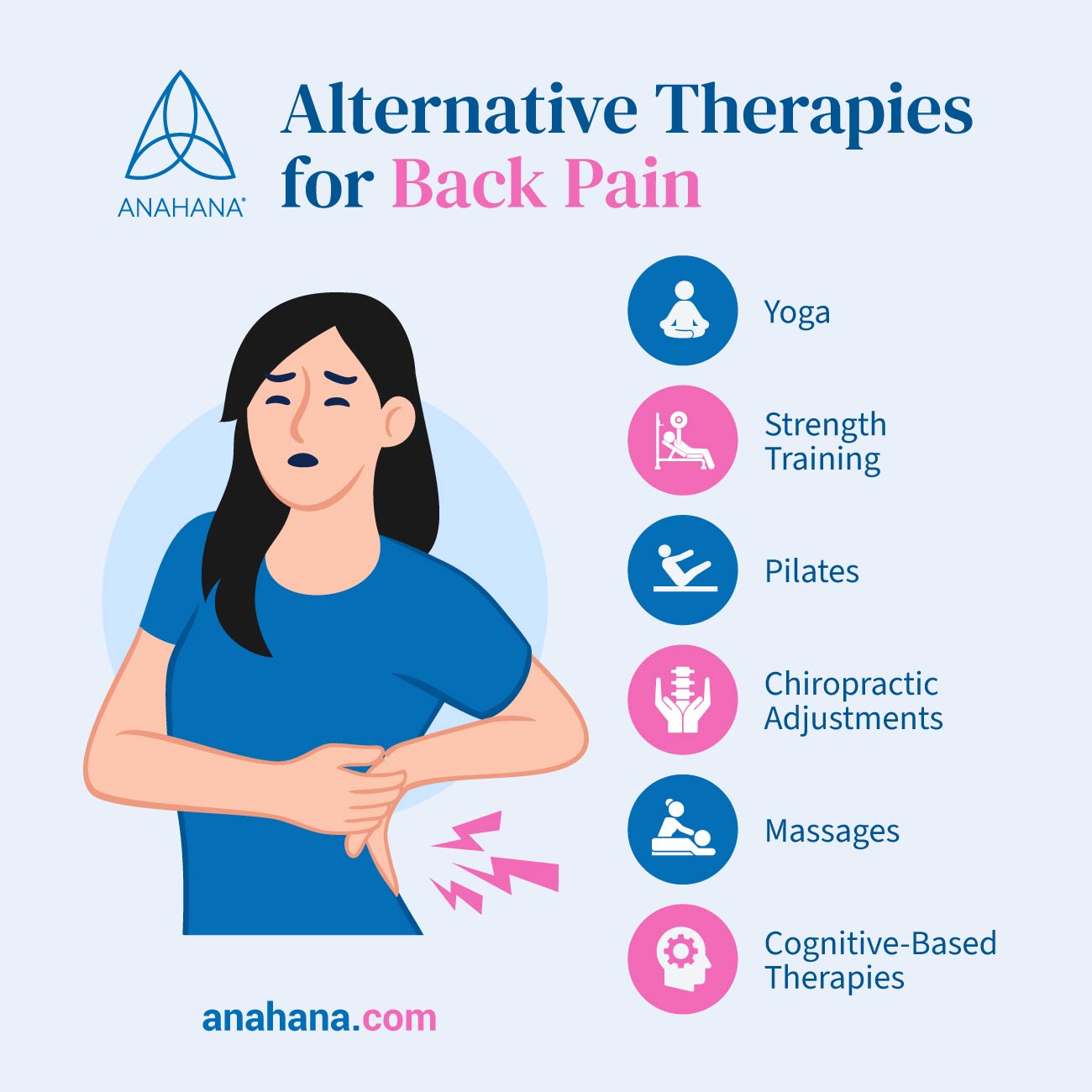
Table of Contents
Back pain refers to any pain and discomfort in the upper, mid, or lower back. Back pain is common and can have many causes, diagnoses, and treatments. Many ways to help prevent back pain include strengthening core muscles, maintaining proper posture, and living an active lifestyle.
Key Takeaways
- Definition: Back pain ranges from mild discomfort to severe pain in the upper, mid, or lower back, often involving the spinal cord.
- Symptoms: Includes muscle aches, shooting pain, and limited flexibility, often worsened by certain movements. Pain can be acute, chronic, or extend to leg pain.
- Causes: Can be due to muscle strain, spinal stenosis, herniated discs, poor posture, and excess weight.
- Diagnosis: Involves medical history, physical exams, MRI, and other imaging techniques.
- Treatments: Options include physical therapy, pain management, medications, and surgery for severe cases. Many cases resolve in a few weeks.
- Prevention: Maintaining strong core and back muscles, proper posture, and a healthy weight helps prevent back pain.
What is Back Pain?
Back pain is a common condition that affects millions of people worldwide. It refers to any discomfort, ache, or pain felt in the region of the back, ranging from the upper back down to the lower back.
The intensity and duration of back pain vary widely, ranging from mild, temporary discomfort to severe, chronic pain that significantly impacts daily activities. Back pain has numerous causes, including muscle strains, ligament sprains, herniated discs, stenosis, and osteoarthritis.
Certain risk factors can increase the likelihood of experiencing back pain, such as:
- Age
- Obesity
- Sedentary lifestyle
- Underlying medical conditions like scoliosis, spinal infections, and osteoporosis
Types of Back Pain
Acute Back Pain
Acute back pain is a sudden onset that lasts relatively short, usually a few days to weeks. It commonly occurs due to a specific injury or strain, such as lifting a heavy object, sudden twisting, or a sports-related incident.
Acute back pain is typically localized and can feel very intense. Rest, pain relievers, and gentle exercises are often recommended for managing back pain, and they tend to improve with time and proper care.
Chronic Back Pain
Chronic back pain is characterized by persistent or recurrent pain that lasts for an extended period, typically beyond three months. It can result from an underlying medical condition or injury, but sometimes the exact cause may be challenging to determine.
Chronic back pain can significantly affect a person's quality of life and daily functioning.
Treatment approaches for chronic back pain often involve a combination of medication, physical therapy, lifestyle modifications, and in some cases, psychological support to help manage the pain and improve functionality.
Mechanical vs. Radicular Back Pain
Mechanical back pain refers to pain that originates from structures within the spine, such as muscles, ligaments, or intervertebral discs. It is often related to poor posture, muscle imbalances, or degenerative changes in the spine.
Mechanical back pain usually worsens with movement or certain positions and may improve with rest or specific exercises targeting the affected area.
Radicular back pain, on the other hand, is caused by irritation or compression of spinal nerves, leading to pain that radiates from the back into the buttocks, legs, or feet.
People often describe this type of pain as sharp, shooting, or electric-like, and it may come with other symptoms such as numbness, tingling, or muscle weakness.
Common causes of radicular back pain include herniated discs, stenosis, or nerve root impingement. Treatment may involve a combination of:
- pain management techniques
- therapy
- surgical intervention to alleviate the pressure on the affected nerve
Causes of Back Pain
Muscle Strain
One of the most common causes of back pain is muscle strain. A muscle strain occurs when the muscles in the back are stretched or torn due to sudden movements, overexertion, or improper lifting techniques.
Muscle strains can result in localized pain and muscle stiffness. Rest, gentle stretching, and applying heat or cold packs can relieve discomfort and promote healing.
Injury and Back Pain
Back pain can also stem from various injuries, such as falls, car accidents, or sports-related incidents. Traumatic injuries can affect the spine, muscles, ligaments, or other soft tissues in the back, leading to pain and limited mobility.
Prompt medical evaluation and appropriate treatment are crucial for managing and preventing further complications associated with back injuries.
Spinal Conditions
Several spinal conditions can contribute to back pain. Herniated discs, where the soft inner material of a spinal disc pushes out through a tear, can irritate nearby nerves and cause pain.
Degenerative conditions like osteoarthritis and spinal stenosis, which involve the breakdown of joints or the narrowing of the canal in the spine, can also result in back pain.
Treatment options for spinal conditions range from conservative approaches like therapy and pain medication to more invasive interventions, including surgery, depending on the severity and cause.
Poor Posture
Maintaining improper posture for prolonged periods can strain the muscles and spinal column excessively, leading to back pain.
Slouching, hunching over a desk, or constantly looking down at electronic devices can contribute to horrible posture.
Making a conscious effort to sit and stand upright, using ergonomic furniture, and taking breaks to stretch and correct posture can help alleviate back pain.
Excessive Weight Gain
Carrying excess weight, especially around the abdomen, can shift the body's center of gravity and strain the muscles in the back.
This excess weight can lead to chronic low back pain. Maintaining a healthy weight through regular exercise, a balanced diet, and lifestyle modifications can reduce the risk of back pain caused by excessive weight gain.
Weak Core Muscles
The abdominal muscles in the back play a crucial role in supporting the spine. Weak core muscles can lead to poor spinal stability and increase the risk of back pain.
Regular strength-training exercises that target the core muscles, such as planks or Pilates, can help strengthen and stabilize the back, reducing the likelihood of pain and injury.
Heavy Lifting
Engaging in activities that involve lifting without proper body mechanics can strain the muscles in the back and spinal structures.
Lifting objects that are too heavy or using improper lifting techniques can lead to acute or chronic back pain.
Learning and utilizing proper lifting techniques, such as bending the knees and lifting with the legs, can help minimize the risk of back injuries during lifting tasks.
Soft Tissue Issues
Structural problems within the spinal canal, such as spinal stenosis, or issues with the soft tissues surrounding the spine, such as muscle strains or ligament sprains, can cause back pain.
These conditions can result in nerve compression or inflammation, leading to localized or radiating pain.
Medical treatment, such as physical therapy, medications, or in severe cases, surgical intervention, may be necessary to address these causes and provide back pain relief.
How to Diagnose Back Pain
When diagnosing back pain, healthcare professionals employ various methods to identify the cause and develop an appropriate treatment plan. The diagnostic process typically involves a combination of:
- Medical history evaluation
- Physical examination
- Imaging studies
During the initial assessment, the healthcare provider will inquire about the nature of the pain, its duration, any triggering events, and factors that alleviate or worsen the symptoms.
They will also ask about the patient's medical history, previous injuries, and any relevant family history of spinal conditions. This information helps in narrowing down potential causes and guiding further evaluation.
A physical examination is performed to assess the patient's posture, range of motion, and the presence of any visible abnormalities or tender areas.
The healthcare provider may perform specific tests to check for muscle strength, sensation, and reflexes in the affected area. They may also examine other body parts, such as the hips or legs, to identify any associated symptoms or signs that can aid in the diagnosis.
In certain cases, additional tests or imaging studies may help to gather more detailed information. These can include X-rays, magnetic resonance imaging (MRI) scans, computed tomography (CT) scans, or electromyography (EMG) tests.
Diagnostic tools help visualize the spinal column, soft tissues, nerves, and other structures, assisting in identifying structural problems, herniated discs, stenosis, or other conditions that may be causing back pain.
It is important to note that the diagnostic process varies depending on the individual case and the suspected cause of back pain. Some cases may require immediate medical attention or further consultations with specialists, such as orthopedic surgeons or neurologists.
The goal is to accurately diagnose the underlying cause and tailor an appropriate treatment plan that may involve a combination of medication, physical therapy, lifestyle modifications, or, in severe cases, surgical intervention.
It is always advisable to consult with a healthcare professional who can assess the individual case and provide the most suitable course of action to alleviate the back pain and promote long-term health.
Medical Treatment for Back Pain
Physical Therapy
Physical therapy is a non-invasive treatment approach for managing back pain. It involves various exercises, stretches, and manual techniques designed to improve strength, flexibility, and overall function of the back and muscles.
A physical therapist creates a personalized treatment plan based on the individual's specific needs, focusing on reducing pain, restoring mobility, and preventing future episodes of back pain.
Physical therapy can also include heat or cold therapy, ultrasound, or electrical stimulation to alleviate pain further and promote healing.
Prescription Medications
In some cases, healthcare professionals may prescribe medications to alleviate back pain.
These medications can include nonsteroidal anti-inflammatory drugs (NSAIDs) to reduce pain and inflammation, relaxants to alleviate painful muscle spasms and promote relaxation, or opioids for severe pain that does not respond to other treatments.
It is important to use prescription medications as directed by a healthcare professional and be aware of potential side effects and associated risks.
Topical Ointments
Topical ointments or creams can provide localized relief for back pain. These over-the-counter or prescription medications contain menthol, camphor, or capsaicin, which numbs the area or reduces inflammation.
Applying topical ointments directly to the site can temporarily relieve muscle aches, stiffness, or mild to moderate back pain.
Muscle Relaxants
Muscle relaxants are medications that help alleviate muscle spasms and reduce muscle tension in the back. They work by targeting the central nervous system to promote relaxation.
Muscle relaxants are typically prescribed for short-term use, as they can cause drowsiness or other side effects. These medications are often used with other treatments, such as physical therapy, to help manage acute episodes of back pain.
Steroid Injections
Steroid injections, also known as corticosteroid injections, can be an option for individuals with severe or chronic back pain that has not responded to other treatments.
These injections deliver anti-inflammatory medication directly into the affected area, such as the spinal joints or the space around the spinal nerves.
Steroid injections can temporarily relieve pain and reduce inflammation, allowing individuals to participate in rehabilitation programs or engage in activities that may help improve their back condition.
Surgery
In some cases, surgery may be recommended for individuals with severe back pain or when conservative treatments are ineffective. Surgical interventions for back pain can vary depending on the cause, such as herniated discs, stenosis, or spinal instability.
Surgery aims to relieve pressure on the spinal nerves, stabilize the spine, or correct structural abnormalities. Surgical procedures may involve removing damaged discs, fusing spinal segments, or decompressing spinal nerves.
Surgery is typically considered a last resort when other treatment options have been exhausted and when the potential benefits outweigh the risks.
Alternative Therapies for Back Pain

Yoga
Yoga is a mind-body practice incorporating gentle stretching, strengthening, and relaxation techniques. It focuses on improving flexibility, posture, and overall body awareness.
Specific yoga poses and sequences can target the muscles and structures of the back, promoting spinal alignment and relieving tension.
Regular yoga can help strengthen the muscles, increase flexibility, and reduce pain.
Pilates
Pilates is a low-impact exercise method that emphasizes core strength, flexibility, and body alignment. It involves controlled movements targeting the deep muscles of the abdomen, back, and hips.
By strengthening the core muscles, Pilates helps stabilize the spine and improve posture, alleviating back pain. The precise movements and focus on proper alignment also enhance body awareness and promote efficient movement patterns, reducing strain on the back.
Massages
Massage therapy involves the manipulation of soft tissues, such as muscles and fascia, to promote relaxation and relieve muscle tension. Various massage techniques, such as Swedish, deep tissue, or trigger point therapy, can benefit individuals with back pain.
Massage helps increase blood flow, reduce muscle tension, and release endorphins, temporarily relieving pain and promoting overall relaxation and well-being.
Strength Training
Strength training exercises, when performed correctly and under the guidance of a qualified professional, can be an effective approach to managing back pain.
Individuals can improve spinal stability and reduce the risk of future back injuries by strengthening the muscles that support the spine, including the glutes, back and abdominal muscles.
Strength training exercises can be tailored to an individual's needs and may include exercises using body weight, resistance bands, or weightlifting equipment.
Chiropractic Adjustments
Chiropractic care focuses on diagnosing and treating musculoskeletal disorders, particularly on the spine. Chiropractors use manual techniques, including spinal adjustments or manipulations, to correct misalignments or imbalances in the spine.
Restoring proper spinal alignment and reducing nerve irritation, chiropractic adjustments aim to alleviate back pain and improve overall function.
Chiropractors may also incorporate other therapies, such as soft tissue mobilization or therapeutic exercises, to complement the adjustments.
Cognitive Based Therapy
Cognitive-based therapy (CBT) is a psychological approach that can benefit individuals experiencing chronic back pain.
It identifies and modifies negative thoughts, beliefs, and behaviors that may contribute to pain perception and emotional distress.
Through cognitive restructuring, relaxation techniques, and coping strategies, CBT helps individuals develop more positive and adaptive ways of managing their pain.
Cognitive-based therapy can enhance overall well-being and improve pain management skills by addressing the psychological factors associated with back pain.
How to Prevent Back Pain
Strong Core Muscles
Having strong core muscles is crucial for maintaining a healthy back. The core muscles, including the abdominal, back, and pelvic floor muscles, provide support and stability to the spine.
Engaging in exercises that target these muscles, such as planks, bridges, and abdominal crunches, can help improve core strength and reduce the risk of back pain.
Working with a qualified professional is important to ensure proper form and technique when performing core exercises.
Proper Posture
Maintaining proper posture is essential for preventing back pain. Whether sitting, standing, or lifting objects, it is important to maintain a neutral spine alignment. Neutral spine alignment means keeping the spine's natural curves intact and avoiding excessive slouching or arching.
Regularly practicing good posture can alleviate stress on the spinal structures and help distribute body weight more evenly. Additionally, using ergonomic furniture, such as supportive chairs and desks, can assist in maintaining proper posture throughout the day.
Lifestyle Tips
Adopting a healthy lifestyle can significantly contribute to the prevention of back pain. Regular exercise, such as walking, swimming, or cycling, can help improve flexibility, strengthen the muscles, and promote overall fitness.
Avoiding a sedentary lifestyle and incorporating movement breaks throughout the day is also important.
Maintaining a healthy weight is crucial, as excess weight can strain the back and contribute to pain. Practicing proper body mechanics during daily activities, such as lifting heavy objects by bending the knees and using the leg muscles rather than relying on the back, is also essential.
Risk Factors for Back Pain
Understanding the risk factors associated with back pain can help individuals take proactive measures to prevent it. Some common risk factors include:
- Age
- Engaging in physically demanding work or activities that involve heavy lifting or repetitive motions can make the pain worse
- Poor physical fitness
- Smoking
- Certain medical conditions, such as obesity or arthritis
By addressing these risk factors through lifestyle modifications and appropriate self-care, individuals can reduce their risk of developing back pain.
References
What low back pain is and why we need to pay attention
Epidemiology of Low Back Pain in Adults
Back Pain: Diagnosis, Treatment, and Steps to Take
Physical therapy for low back pain
Physical Therapy Approaches in the Treatment of Low Back Pain
Disclaimer
The contents of this article are provided for informational purposes only and are not intended to substitute for professional medical advice, diagnosis, or treatment. It is always recommended to consult with a qualified healthcare provider before making any health-related changes or if you have any questions or concerns about your health. Anahana is not liable for any errors, omissions, or consequences that may occur from using the information provided.

By: Anahana
The Anahana team of researchers, writers, topic experts, and computer scientists come together worldwide to create educational and practical wellbeing articles, courses, and technology. Experienced professionals in mental and physical health, meditation, yoga, pilates, and many other fields collaborate to make complex topics easy to understand.
